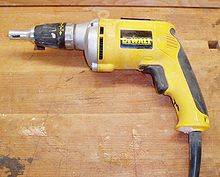Electric screwdriver
An electric screwdriver is an electrically powered device for screwing in and out screws and nuts .
Executions
A basic distinction can be made between the two types of screwdrivers:
- an electric motor drives the work spindle either directly or via a gearbox . The torque on the screw connection must be countered. This principle is implemented in the cordless screwdriver .
- an electric motor drives the work spindle via a hammer mechanism, as in a pulse screwdriver . In this way, a significantly higher torque can be achieved on the screw connection than has to be countered.
Both versions are mains operated or battery operated . Some of the electric screwdrivers are also available for operation on a vehicle electrical system with a nominal voltage of 12 V or 24 V. For particularly precise screwdriving applications, the screwdriving controls offer higher accuracy and additional functions.
Start of the screwdriver
When starting the screwdriver there are two basic types.
- In the first case, the screwing process begins by manually pressing the switch on the screwdriver.
- In the other case, they do not have a switch for manual release. The screwdriver starts running when the screwdriver with the screw bit is placed on the screw and manual pressure is exerted on the screw with the screwdriver.
In addition, most electric screwdrivers have an additional switch that can be used to change the direction of rotation of the screwdriver.
advantages and disadvantages
The electric screwdrivers switch off the screwdriving process when the nominal torque is reached. A warming of the screwdriver usually has no negative effects on the screwdriver itself. The electrical connection line for an electric screwdriver is usually lighter than the compressed air line for a pneumatic screwdriver . Furthermore, compared to pneumatic screwdrivers, electric screwdrivers usually have a significantly lower tolerance for the switch-off torque. Furthermore, no oil mist is released into the environment with the electric screwdriver , as is the case with the compressed air screwdriver. With an electric screwdriver, a simple socket is usually sufficient, while the compressed air screwdriver requires a separate infrastructure for the compressed air system ( compressor , piping , pressure reducer , oiler, ...). With the regulated electric screwdriver, voltage fluctuations in the power supply have almost no influence on the precision of the electric screwdriver. As a further advantage, the electric screwdrivers often have the option of a soft start.
In the case of electrical devices, overheating can damage the device. This can lead to failure of the electric screwdriver. In contrast to the pneumatic screwdriver, the electric screwdriver cannot be overloaded as much.

